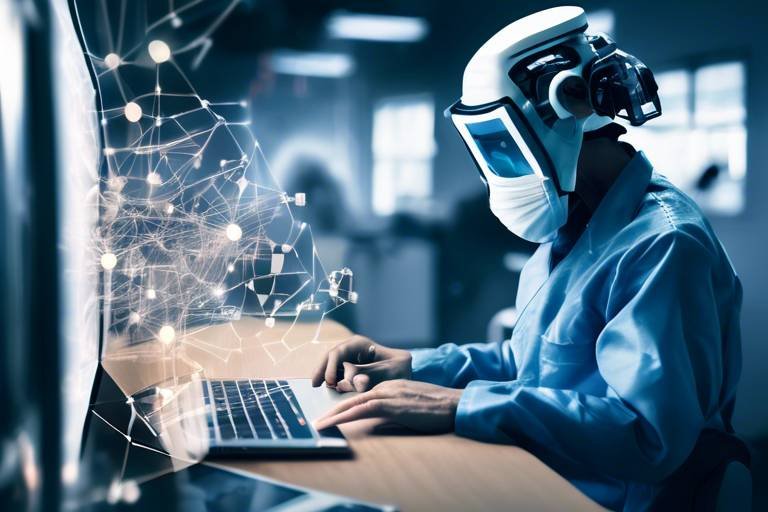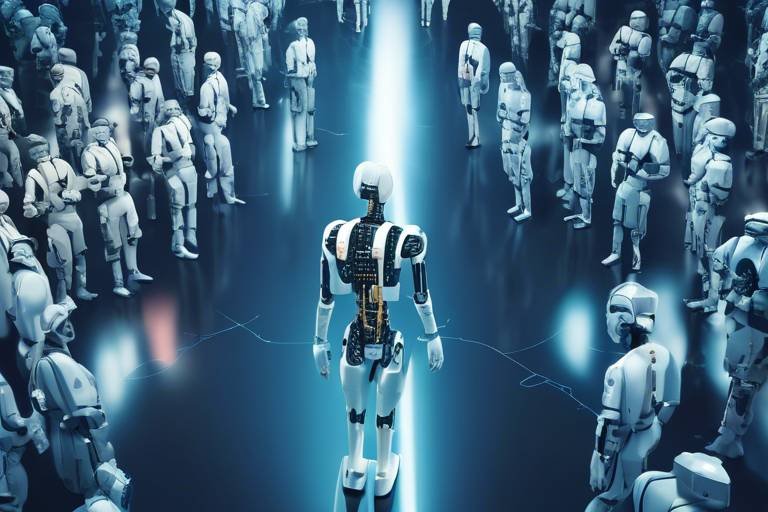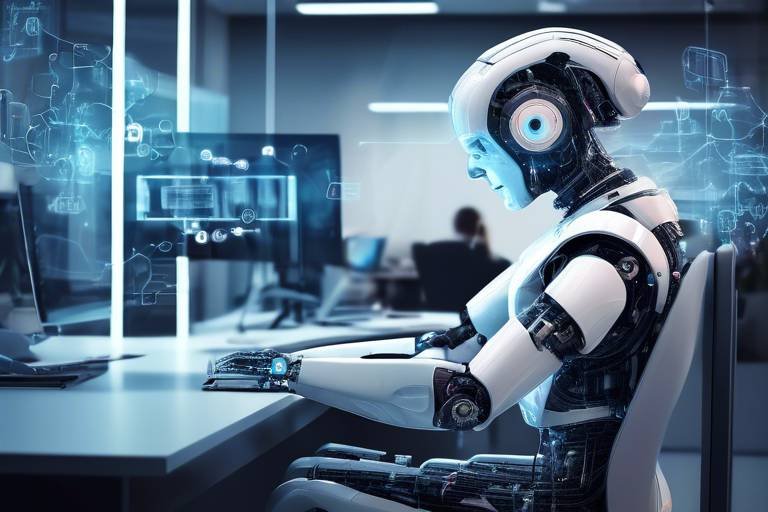Utilizing AI to Enhance Workplace Productivity
In today's fast-paced business environment, the quest for improved efficiency and productivity is more crucial than ever. Enter artificial intelligence (AI), a game-changer that is revolutionizing how organizations operate. Imagine a workplace where mundane tasks are automated, decision-making is data-driven, and employee training is tailored to individual needs. Sounds like a dream, right? Well, it's becoming a reality thanks to AI! This article explores various ways artificial intelligence can improve efficiency and productivity in the workplace, highlighting tools, strategies, and real-world applications that can transform organizational performance.
One of the most significant advantages of AI is its ability to streamline repetitive tasks. Think about all those hours spent on mundane activities like data entry, scheduling meetings, or managing emails. What if you could free up that time for more strategic initiatives? With AI-powered automation tools, this is now possible. For instance, tools like Zapier and UiPath can automate workflows, allowing employees to concentrate on high-value tasks that require creativity and critical thinking. By reducing the time spent on repetitive tasks, organizations can boost overall productivity and employee satisfaction.
Artificial intelligence excels at processing large datasets quickly, offering insights that drive informed decision-making. In a world where data is often referred to as the new oil, the ability to analyze this data effectively can set businesses apart. AI analytics tools, such as Tableau and Google Analytics, can sift through mountains of data to uncover trends and patterns that might otherwise go unnoticed. This not only enhances business strategies but also enables organizations to make data-driven decisions that can lead to increased profitability.
Predictive analytics uses historical data to forecast future trends, enabling organizations to plan effectively. By leveraging AI, businesses can anticipate changes in the market, customer preferences, and even operational challenges. For example, retail companies can use predictive analytics to optimize inventory levels, ensuring they meet customer demand without overstocking. The benefits of this approach are immense, particularly in resource allocation and project management, where being proactive can save time and money.
Imagine having the ability to monitor your business operations in real-time, responding swiftly to changing conditions. Real-time monitoring powered by AI can help organizations achieve just that. Tools like Microsoft Power BI and IBM Watson provide immediate insights into various metrics, allowing teams to make timely decisions that can significantly impact performance. This agility can be the difference between seizing an opportunity and missing out.
Understanding customer behaviors and preferences is paramount for any business looking to thrive. AI can analyze vast amounts of customer data, providing businesses with a deeper understanding of their audience. By leveraging this knowledge, companies can tailor their marketing strategies, enhance customer experiences, and ultimately drive sales. For example, AI tools can segment customers based on their buying habits, allowing for more personalized marketing campaigns that resonate with specific groups.
Effective communication is the backbone of any successful organization. AI-driven communication platforms can facilitate collaboration and information sharing among teams, breaking down silos and fostering a culture of transparency. Tools like Slack and Microsoft Teams are incorporating AI features that help prioritize messages, schedule meetings, and even provide language translation, making it easier for teams to work together, regardless of their geographical locations.
Employee development is crucial for maintaining a competitive edge, and AI can personalize training programs to ensure that employees receive the resources they need to grow. By analyzing individual performance and learning styles, AI can tailor educational content, making training more engaging and effective. This not only boosts employee morale but also enhances retention rates as employees feel more invested in their development.
Adaptive learning systems leverage AI to customize educational experiences for each learner. This means that employees can progress at their own pace, focusing on areas where they need improvement. For instance, platforms like Coursera and LinkedIn Learning utilize AI to recommend courses based on an individual's skill set, ensuring that training is relevant and impactful.
Combining virtual reality with AI creates immersive training experiences that can significantly enhance skill acquisition and retention. Imagine a new employee being able to practice their skills in a virtual environment that simulates real-life scenarios. This hands-on approach not only boosts confidence but also prepares employees for the challenges they may face in their roles.
To truly understand how productive your organization is, you need the right metrics and analytics. AI tools can provide organizations with detailed insights into performance, helping to identify areas for improvement. Tools like Asana and Trello offer analytics features that track project progress and team productivity, enabling managers to make informed decisions that drive performance.
Performance dashboards aggregate data to visualize productivity metrics. These dashboards can be customized to display key performance indicators (KPIs) that matter most to your organization. By having a clear view of performance metrics, managers can quickly identify trends and make adjustments as needed, fostering a culture of continuous improvement.
AI can also analyze employee feedback to identify areas for improvement. By leveraging sentiment analysis tools, organizations can gain insights into employee satisfaction and engagement levels. This data can be invaluable in enhancing workplace culture and productivity, ensuring employees feel heard and valued.
- How can AI improve workplace productivity?
AI enhances productivity by automating repetitive tasks, providing data-driven insights, and personalizing employee training. - What are some popular AI tools for task automation?
Tools like Zapier and UiPath are widely used for automating workflows in various industries. - How does AI help in employee training?
AI personalizes training programs to fit individual learning styles, making training more effective and engaging. - Can AI improve customer insights?
Yes, AI analyzes customer data to provide deeper insights into behaviors and preferences, helping businesses tailor their marketing strategies.

The Role of AI in Task Automation
In today’s fast-paced work environment, efficiency is the name of the game. Imagine a world where mundane, repetitive tasks are handled by machines, freeing up human minds for more creative and strategic endeavors. This is where artificial intelligence (AI) steps in, revolutionizing the way we approach our daily tasks. AI can significantly streamline processes, allowing employees to focus on high-value activities that require human insight and creativity.
One of the most exciting aspects of AI is its ability to automate tasks that once consumed hours of time. For instance, consider the process of data entry. Traditionally, this task involved painstakingly inputting information into spreadsheets or databases. With AI-driven automation tools, this process can be completed in a fraction of the time, reducing the risk of human error and improving overall accuracy. Imagine the productivity boost when employees can redirect their efforts from data entry to analyzing trends and making informed decisions!
Here are some key areas where AI is making a significant impact in task automation:
- Customer Support: AI chatbots can handle common inquiries, providing instant responses and freeing up human agents for more complex issues.
- Document Management: AI tools can automatically categorize and tag documents, making it easier to retrieve important information quickly.
- Email Filtering: AI can prioritize emails based on urgency and relevance, helping employees manage their inboxes more effectively.
The implementation of these AI tools not only enhances productivity but also boosts employee morale. When team members are relieved from monotonous tasks, they can engage in more fulfilling work that fosters creativity and innovation. It’s akin to a gardener who, instead of pulling weeds all day, gets to plant vibrant flowers and nurture their growth.
Additionally, AI-driven automation tools can provide invaluable insights into workflow efficiency. By analyzing data on how tasks are completed, organizations can identify bottlenecks and optimize processes further. This continuous improvement cycle is crucial for maintaining a competitive edge in any industry.
As we look toward the future, the role of AI in task automation will only expand. Businesses that embrace these technologies will not only enhance their operational efficiency but also create a more engaged and satisfied workforce. Imagine a workplace where employees are empowered to focus on what they do best, leading to greater job satisfaction and improved outcomes for the organization.
In conclusion, the integration of AI into task automation is not just a trend; it’s a fundamental shift in how we work. By leveraging these innovative tools, organizations can unlock new levels of productivity and creativity, transforming the workplace into a hub of innovation and collaboration.

AI-Powered Data Analysis
In today's fast-paced business environment, the ability to make informed decisions quickly is paramount. This is where comes into play. Imagine having a virtual assistant that can sift through mountains of data in a matter of seconds, extracting valuable insights that would take a human analyst days or even weeks to uncover. With the power of artificial intelligence, organizations can leverage data like never before, transforming raw numbers into actionable strategies.
AI excels at processing large datasets, identifying patterns, and generating insights that can drive informed decision-making. For instance, consider a retail company that wants to understand its customers better. By utilizing AI analytics, the company can analyze purchasing behaviors, seasonal trends, and customer feedback to tailor its offerings. This not only enhances customer satisfaction but also boosts sales, making the company more competitive in the market.
Moreover, AI-powered data analysis can be a game-changer for businesses looking to optimize their operations. By employing machine learning algorithms, organizations can predict future trends based on historical data. This predictive capability allows businesses to allocate resources more effectively and plan for upcoming demands. For example, a manufacturing firm can forecast production needs, reducing waste and ensuring that they meet customer demands without overextending their resources.
Predictive analytics is a fascinating aspect of AI that uses historical data to forecast future outcomes. This technique is invaluable for organizations aiming to enhance their planning processes. By analyzing past performance and current market conditions, businesses can make educated guesses about future trends. For instance, a company launching a new product can use predictive analytics to estimate potential sales and customer interest, allowing them to adjust their marketing strategies accordingly.
Here are some key benefits of predictive analytics:
- Resource Allocation: Businesses can allocate resources more efficiently by anticipating demand.
- Risk Management: Identifying potential risks before they become issues can save time and money.
- Strategic Planning: Organizations can develop long-term strategies based on predicted trends, ensuring they stay ahead of the competition.
Another significant advantage of AI in data analysis is real-time monitoring. Imagine a scenario where a company can track its sales performance, customer interactions, and market trends in real time. With AI tools, this is not just a dream—it's a reality. Real-time data monitoring allows organizations to respond swiftly to changing conditions, ensuring they remain agile and competitive.
Tools such as dashboards and analytics platforms provide immediate insights, enabling decision-makers to act on the latest information. For example, if a sudden drop in sales is detected, management can quickly investigate the cause and implement corrective actions before the issue escalates. This capability is particularly beneficial in industries like retail and e-commerce, where consumer preferences can shift rapidly.
AI can also significantly enhance customer insights by analyzing behaviors and preferences. By examining data from various touchpoints—such as social media interactions, website visits, and purchase history—AI tools can create comprehensive profiles of customers. This knowledge enables businesses to tailor their marketing strategies, ensuring they deliver the right message to the right audience.
For instance, a company can use AI to segment its customer base into different categories, allowing for personalized marketing campaigns that resonate more deeply with each group. This not only improves customer engagement but also increases conversion rates, as tailored messages are far more effective than generic ones.
In conclusion, is revolutionizing the way organizations operate. By leveraging advanced analytics, businesses can make informed decisions, optimize their strategies, and ultimately enhance their performance. As we continue to embrace the capabilities of AI, the future of data analysis looks brighter than ever.
Q: What is AI-powered data analysis?
A: AI-powered data analysis refers to the use of artificial intelligence technologies to analyze large sets of data, uncover patterns, and generate insights that can inform business decisions.
Q: How does predictive analytics work?
A: Predictive analytics uses historical data to identify trends and forecast future outcomes, helping businesses plan more effectively and allocate resources efficiently.
Q: What are the benefits of real-time data monitoring?
A: Real-time data monitoring allows organizations to respond quickly to changes in the market, improve decision-making, and enhance operational efficiency.
Q: How can AI improve customer insights?
A: AI analyzes customer behavior and preferences to create detailed profiles, enabling businesses to tailor their marketing strategies for better engagement and conversion rates.

Predictive Analytics for Better Planning
Predictive analytics is like having a crystal ball for your business; it takes historical data and turns it into foresight, allowing organizations to anticipate future trends and make informed decisions. Imagine being able to predict customer demand, optimize inventory, or even foresee potential project delays before they become a reality. This is the power of predictive analytics, and it's transforming how companies plan their strategies.
At its core, predictive analytics leverages statistical algorithms and machine learning techniques to analyze patterns in data. By examining past behaviors and outcomes, businesses can identify trends that inform future actions. For instance, a retail company can analyze purchasing patterns from previous years to forecast sales for the upcoming holiday season. This not only helps in stocking the right amount of inventory but also in planning marketing campaigns that resonate with customer expectations.
Here’s a deeper look at how predictive analytics can enhance planning in various organizational aspects:
- Resource Allocation: By predicting project timelines and resource needs, teams can allocate their workforce and materials more efficiently, reducing waste and ensuring that projects stay on track.
- Risk Management: Predictive analytics can help identify potential risks before they escalate, allowing businesses to implement mitigation strategies proactively.
- Financial Planning: Organizations can forecast revenue and expenses more accurately, enabling better budgeting and financial decision-making.
Moreover, the integration of predictive analytics into project management tools can significantly improve outcomes. For example, tools that utilize predictive analytics can alert managers about potential delays based on current project progress compared to historical data. This allows for timely interventions, ensuring that projects remain within scope and budget.
To illustrate the benefits of predictive analytics, consider the following table that summarizes its impact across various industries:
| Industry | Use Case | Benefits |
|---|---|---|
| Retail | Sales Forecasting | Optimized inventory, improved customer satisfaction |
| Healthcare | Patient Outcome Predictions | Enhanced patient care, reduced readmission rates |
| Manufacturing | Predictive Maintenance | Reduced downtime, lower maintenance costs |
| Finance | Fraud Detection | Increased security, minimized losses |
In conclusion, predictive analytics is not just a buzzword; it's a game-changer for organizations looking to enhance their planning processes. By leveraging data-driven insights, businesses can not only prepare for what's coming but also position themselves to seize opportunities as they arise. As we move forward, the companies that embrace predictive analytics will likely lead the charge in their respective industries, demonstrating the undeniable value of being proactive rather than reactive.
1. What is predictive analytics?
Predictive analytics involves using statistical algorithms and machine learning techniques to analyze historical data and predict future outcomes.
2. How can predictive analytics benefit my business?
It can help improve decision-making, optimize resource allocation, manage risks, and enhance financial planning by providing actionable insights based on data trends.
3. What industries can benefit from predictive analytics?
Almost every industry can benefit, including retail, healthcare, manufacturing, and finance, as it helps in various applications like sales forecasting, patient care, maintenance, and fraud detection.
4. What tools are available for predictive analytics?
There are numerous tools available, such as IBM Watson, Microsoft Azure Machine Learning, and Google Cloud AI, which offer robust capabilities for predictive analytics.

Real-Time Data Monitoring
In today's fast-paced business environment, the ability to respond to changes in real-time is not just a luxury; it’s a necessity. powered by artificial intelligence equips organizations with the tools to swiftly adapt to evolving circumstances. Imagine being able to see exactly what’s happening in your company at any given moment, much like having a live dashboard of your vehicle's performance while driving. This capability allows businesses to make informed decisions almost instantaneously, significantly enhancing their operational efficiency.
AI-driven monitoring tools analyze vast amounts of data from various sources, including sales figures, customer interactions, and operational metrics. These tools provide immediate insights that can be crucial in times of uncertainty. For instance, if a sudden spike in customer inquiries is detected, a company can quickly allocate resources to address the demand, ensuring that customer satisfaction remains high. This responsiveness not only improves service quality but also boosts employee morale, as teams feel empowered to tackle challenges head-on.
Moreover, real-time monitoring can help identify trends and anomalies that might otherwise go unnoticed. By leveraging AI algorithms, businesses can set up alerts for unusual patterns, such as a drop in sales or an increase in production defects. This proactive approach allows organizations to investigate and resolve issues before they escalate, preventing costly mistakes. For example, a retail company might notice a decrease in foot traffic in one of its stores and can investigate the cause, whether it’s a marketing misstep or a competitor’s promotion. By addressing the issue promptly, they can adjust their strategy and recapture lost customers.
To illustrate the impact of real-time data monitoring, consider the following table that highlights key benefits:
| Benefit | Description |
|---|---|
| Immediate Insights | Access to up-to-the-minute data helps in making swift decisions. |
| Proactive Problem Solving | Identifying issues before they escalate minimizes risks. |
| Enhanced Customer Experience | Quick adjustments to service can lead to higher satisfaction rates. |
| Informed Resource Allocation | Data-driven decisions ensure resources are used effectively. |
In conclusion, the integration of real-time data monitoring into business operations is a game-changer. It allows organizations to stay ahead of the curve, adapt to changes, and ultimately improve their bottom line. As we continue to embrace the digital age, the importance of having these tools at our disposal cannot be overstated. They not only provide clarity in the chaos but also empower teams to act decisively, making them invaluable assets in today’s competitive landscape.
- What is real-time data monitoring?
Real-time data monitoring refers to the continuous tracking of data as it is generated, allowing businesses to respond to information instantaneously. - How does AI enhance real-time monitoring?
AI enhances real-time monitoring by analyzing large datasets quickly, identifying trends, and providing actionable insights that can inform decision-making. - What are some examples of real-time monitoring tools?
Examples include Google Analytics for web traffic, social media monitoring tools, and customer relationship management (CRM) systems that provide live updates on customer interactions.

Improving Customer Insights
In today's fast-paced business environment, understanding your customers is more crucial than ever. Artificial Intelligence plays a transformative role in enhancing customer insights, enabling businesses to tailor their offerings and marketing strategies effectively. Imagine having a crystal ball that reveals not just what your customers are buying, but why they are making those choices. This is precisely what AI can provide through its sophisticated data analysis capabilities.
By leveraging AI algorithms, companies can analyze vast amounts of customer data—from purchase histories to social media interactions. This analysis uncovers patterns and trends that might otherwise go unnoticed. For instance, AI can identify which products are frequently purchased together or how seasonal changes affect buying behavior. With these insights, businesses can create targeted marketing campaigns that resonate with their audience.
Furthermore, AI tools can segment customers based on their behaviors and preferences. This segmentation allows for more personalized marketing efforts, which can significantly enhance customer engagement. For example, instead of sending a generic email blast, a business can use AI to send tailored recommendations based on a customer's past interactions. This level of personalization not only improves customer satisfaction but also increases the likelihood of repeat purchases.
To illustrate the impact of AI on customer insights, consider the following table:
| AI Tool | Functionality | Benefit |
|---|---|---|
| Sentiment Analysis | Analyzes customer feedback and reviews | Identifies customer satisfaction and areas for improvement |
| Predictive Analytics | Forecasts future buying trends | Enables proactive inventory and marketing strategies |
| Customer Segmentation | Groups customers based on behaviors | Facilitates personalized marketing efforts |
Moreover, AI can enhance customer insights through real-time data analysis. Imagine being able to see how a marketing campaign performs as it unfolds. AI tools can provide immediate feedback, allowing businesses to adjust their strategies on the fly. This agility is vital in maintaining relevance in a competitive market.
In conclusion, the integration of AI into customer insight strategies not only enhances understanding but also fosters stronger relationships with customers. By utilizing AI to analyze data, segment audiences, and personalize marketing efforts, businesses can transform their approach to customer engagement. In a world where customer preferences are constantly evolving, harnessing the power of AI is not just an option; it's a necessity for success.
- How does AI improve customer insights? AI analyzes large datasets to uncover patterns and trends, allowing businesses to understand customer behaviors and preferences better.
- What types of data can AI analyze? AI can analyze various data types, including purchase histories, social media interactions, and customer feedback.
- Can AI help in personalizing marketing efforts? Yes, AI can segment customers and provide tailored recommendations, enhancing the effectiveness of marketing campaigns.
- Is real-time data analysis possible with AI? Absolutely! AI tools can provide immediate insights, enabling businesses to adjust their strategies in real-time.

AI in Communication Tools
In today’s fast-paced work environment, effective communication is crucial for success. Enter artificial intelligence, a game-changer in the realm of workplace communication. Imagine having a virtual assistant that not only helps you draft emails but also understands the context of your conversations, making suggestions that enhance clarity and engagement. AI-powered communication tools are designed to streamline interactions, foster collaboration, and ensure that teams stay connected, no matter where they are.
One of the most significant advantages of AI in communication tools is the ability to analyze conversations in real-time. For instance, platforms like Slack and Microsoft Teams are integrating AI features that can summarize discussions, highlight action points, and even remind team members of deadlines. This functionality is akin to having a personal note-taker who captures the essence of meetings without the need for manual input. As a result, employees can focus on what truly matters—collaborating and innovating.
Moreover, AI can enhance customer communication through chatbots and virtual assistants. These tools can handle customer inquiries 24/7, providing instant responses and freeing up human agents to tackle more complex issues. Imagine a customer service scenario where a customer receives immediate assistance for a simple query while the support team dedicates their time to resolving intricate problems. This not only improves customer satisfaction but also boosts overall productivity within the organization.
AI tools also facilitate better team collaboration. For example, platforms like Trello and Asana use AI to prioritize tasks based on deadlines and team member availability, allowing for more efficient project management. With AI, teams can receive intelligent recommendations on who should work on what, ensuring that resources are utilized effectively. This leads to improved workflow and a more harmonious working environment.
To further illustrate the impact of AI in communication tools, consider the following table that compares traditional communication methods with AI-enhanced solutions:
| Aspect | Traditional Communication | AI-Enhanced Communication |
|---|---|---|
| Response Time | Variable; often delayed | Instantaneous |
| Task Management | Manual tracking | Automated prioritization |
| Meeting Summaries | Requires manual notes | Automated summaries and action points |
| Customer Support | Limited hours of operation | 24/7 support availability |
In conclusion, AI in communication tools is revolutionizing how organizations interact both internally and externally. By leveraging these advanced technologies, businesses can foster a culture of collaboration, enhance productivity, and ultimately drive better outcomes. As AI continues to evolve, the possibilities for improving communication in the workplace are limitless, making it an exciting area to watch.
- How does AI improve workplace communication?
AI enhances workplace communication by automating routine tasks, providing real-time insights, and facilitating better collaboration among team members. - What are some examples of AI communication tools?
Some popular AI communication tools include Slack, Microsoft Teams, Trello, and Asana, which integrate AI features to streamline workflows. - Can AI replace human communication entirely?
No, AI is designed to assist and enhance human communication, not replace it. The human touch is still essential for building relationships and understanding nuances. - How can businesses measure the effectiveness of AI communication tools?
Businesses can measure the effectiveness of AI communication tools by tracking metrics such as response times, customer satisfaction scores, and team productivity levels.

Enhancing Employee Training with AI
In today's fast-paced work environment, companies are constantly seeking innovative ways to enhance employee training. This is where artificial intelligence (AI) steps in as a game-changer. By leveraging AI technologies, organizations can create training programs that are not only more effective but also tailored to meet the unique needs of each employee. Imagine a world where training is no longer a one-size-fits-all approach but rather a customized journey that evolves with the learner. Sounds exciting, right?
AI can analyze individual performance data and learning styles, allowing companies to develop personalized training programs. This ensures that employees receive the resources they need to thrive in their roles. For instance, if an employee struggles with a specific skill, AI can recommend targeted training modules that focus on that area. This kind of tailored approach not only boosts engagement but also fosters a culture of continuous learning. After all, who wouldn’t want to learn in a way that suits them best?
One of the most fascinating advancements in AI-driven training is the emergence of adaptive learning systems. These systems dynamically adjust the content based on the learner's progress, ensuring that they are neither bored nor overwhelmed. Imagine being in a training session where the material adapts to your pace and understanding. This not only enhances knowledge retention but also keeps employees motivated to learn. According to recent studies, companies that implement adaptive learning systems see a 30% increase in employee engagement compared to traditional training methods.
Moreover, the integration of virtual reality (VR) with AI is revolutionizing the training landscape. By creating immersive training experiences, companies can simulate real-world scenarios that employees may face in their roles. For example, a retail employee can practice customer interactions in a virtual store environment, allowing them to refine their skills without the pressure of a live setting. This hands-on experience can significantly enhance skill acquisition and retention, making employees feel more prepared and confident when they face actual challenges.
To illustrate the potential of AI in training, consider the following table that highlights key benefits:
| Benefit | Description |
|---|---|
| Personalization | Training programs tailored to individual learning styles and needs. |
| Engagement | Increased motivation through adaptive learning systems. |
| Real-World Simulations | Use of VR to practice skills in a safe, controlled environment. |
| Continuous Improvement | Ongoing adjustments and updates to training content based on employee feedback and performance. |
In conclusion, the integration of AI in employee training is not just a trend; it's a necessity for organizations that wish to remain competitive. By adopting AI-driven training solutions, companies can empower their workforce, enhance productivity, and create a more dynamic learning environment. So, are you ready to embrace the future of training and unlock the full potential of your employees?
- How does AI personalize training programs? AI analyzes individual performance data and learning styles to create tailored content that meets each employee's unique needs.
- What are adaptive learning systems? These systems adjust training content dynamically based on the learner's progress, ensuring an optimal learning experience.
- Can virtual reality improve training outcomes? Yes, VR provides immersive experiences that simulate real-world scenarios, enhancing skill acquisition and retention.
- What benefits can companies expect from AI-enhanced training? Companies can expect increased employee engagement, improved skill retention, and a more prepared workforce.

Adaptive Learning Systems
In today's fast-paced world, where change is the only constant, traditional training methods often fall short. Enter , a game-changer in employee development. These systems leverage the power of artificial intelligence to create personalized learning experiences that cater to the unique needs of each employee. Imagine a training program that evolves based on your progress, strengths, and weaknesses—sounds revolutionary, right?
Adaptive learning systems analyze individual performance data in real-time, allowing them to adjust the learning path dynamically. This means that if an employee struggles with a particular concept, the system can offer additional resources or alternative explanations to help them grasp the material. Conversely, if someone excels, the system can accelerate their learning, presenting more challenging content to keep them engaged. This tailored approach not only enhances learning outcomes but also boosts employee motivation and satisfaction.
Moreover, these systems can incorporate various learning styles, recognizing that not everyone absorbs information the same way. For instance, some employees may prefer visual aids, while others might benefit from hands-on experiences. By offering a mix of content types—videos, quizzes, interactive simulations—adaptive learning systems ensure that all employees can engage with the material in a way that resonates with them. This flexibility is crucial in fostering a culture of continuous learning within organizations.
To illustrate the effectiveness of adaptive learning systems, consider the following table that compares traditional learning methods with adaptive learning:
| Aspect | Traditional Learning | Adaptive Learning |
|---|---|---|
| Personalization | One-size-fits-all | Tailored to individual needs |
| Feedback | Delayed and general | Real-time and specific |
| Engagement | Passive learning | Interactive and dynamic |
| Learning Pace | Fixed schedule | Self-paced and flexible |
As organizations increasingly recognize the value of adaptive learning systems, they are not only enhancing employee skill sets but also fostering a culture where continuous improvement is the norm. This leads to a more competent workforce, ready to tackle the challenges of an ever-evolving business landscape.
In conclusion, adaptive learning systems represent a significant step forward in employee training. By personalizing the learning experience and making it more engaging, these systems help organizations unlock the full potential of their workforce. So, if you're looking to boost employee performance and satisfaction, investing in adaptive learning technology might just be the way to go!
- What is an adaptive learning system?
An adaptive learning system is a technology that personalizes educational experiences based on individual learning styles and performance. - How does adaptive learning improve employee training?
It tailors the learning process to meet the specific needs of each employee, enhancing engagement and retention of information. - Can adaptive learning systems be integrated with existing training programs?
Yes, many adaptive learning systems are designed to complement and enhance existing training frameworks. - What types of content do adaptive learning systems use?
These systems utilize a variety of content types, including videos, quizzes, and interactive simulations, to cater to different learning preferences.

Virtual Reality and AI for Training
Imagine stepping into a world where you can practice your skills without the fear of making mistakes. Virtual Reality (VR) combined with Artificial Intelligence (AI) is revolutionizing the way we approach employee training. This powerful duo creates immersive environments that not only engage learners but also enhance their retention of critical information. By simulating real-world scenarios, VR allows employees to experience situations they might face on the job, providing a safe space to learn and grow.
One of the most exciting aspects of VR training is its ability to adapt to the individual needs of each employee. With AI algorithms analyzing user performance in real-time, training programs can be tailored to address specific weaknesses or skill gaps. For instance, if an employee struggles with a particular task, the AI can modify the training content to offer additional practice in that area. This personalized approach leads to a more effective learning experience and ultimately boosts confidence and competence in the workplace.
Furthermore, VR training can significantly reduce costs associated with traditional training methods. Instead of investing in expensive physical resources or travel for training sessions, organizations can create virtual environments that employees can access from anywhere. This not only saves money but also time, allowing employees to learn at their own pace and on their own schedule. In fact, studies have shown that VR training can lead to a 75% improvement in training retention compared to conventional methods.
To illustrate the effectiveness of VR and AI in training, consider the following table that outlines key benefits:
| Benefit | Description |
|---|---|
| Enhanced Engagement | Immersive experiences capture attention and motivate learners. |
| Personalized Learning | AI tailors training to individual needs, improving outcomes. |
| Cost Efficiency | Reduces expenses related to materials and travel. |
| Improved Retention | Higher retention rates lead to better performance on the job. |
Moreover, VR training is not limited to technical skills; it can also enhance soft skills like communication and teamwork. For example, employees can engage in simulated conversations or group projects in a virtual setting, allowing them to practice and refine their interpersonal skills. This type of training is particularly beneficial for roles that require customer interaction, as it prepares employees to handle various scenarios they might encounter.
In conclusion, the integration of Virtual Reality and AI into training programs is a game-changer for organizations striving to enhance employee performance. By creating realistic, adaptable, and engaging training environments, businesses can ensure their workforce is well-prepared to meet the challenges of today's fast-paced work environment. As technology continues to evolve, the possibilities for VR and AI in training are virtually limitless.
- What is the primary benefit of using VR for training?
VR provides immersive experiences that enhance engagement and retention, making learning more effective. - How does AI personalize training?
AI analyzes employee performance and adjusts training content to focus on individual strengths and weaknesses. - Can VR training be used for soft skills development?
Yes, VR can simulate real-life interactions, helping employees practice communication and teamwork skills. - Is VR training cost-effective?
Absolutely! VR reduces the need for physical resources and travel, leading to significant cost savings.

Measuring Productivity with AI Tools
In today's fast-paced business environment, measuring productivity is more crucial than ever. With the advent of artificial intelligence (AI), organizations can now gain deeper insights into their performance metrics than they ever thought possible. AI tools not only help in tracking productivity but also provide actionable insights that can lead to significant improvements. Imagine having a personal assistant that not only keeps an eye on your daily tasks but also suggests how to optimize your workflow. That's the power of AI in productivity measurement!
One of the most effective ways AI contributes to measuring productivity is through the use of performance dashboards. These dashboards aggregate data from various sources, presenting it in a visually appealing and easily digestible format. For instance, a sales team can monitor their performance metrics such as conversion rates, average deal size, and sales cycle length all in one place. This comprehensive view allows managers to identify trends, spot areas for improvement, and make informed decisions quickly.
But what exactly does a performance dashboard look like? Here's a simple representation of how different metrics can be organized:
| Metric | Current Value | Target Value | Variance |
|---|---|---|---|
| Sales Growth | 15% | 20% | -5% |
| Customer Satisfaction | 85% | 90% | -5% |
| Employee Productivity | 75% | 80% | -5% |
This table illustrates how organizations can easily track their performance against set targets, allowing them to adjust strategies as necessary. Furthermore, AI tools can analyze historical data to identify patterns and predict future performance. This capability is particularly beneficial for resource allocation and project management, helping companies to optimize their operations effectively.
Another significant aspect of measuring productivity with AI is the use of employee feedback systems. These systems can analyze qualitative and quantitative feedback from employees, providing insights into their satisfaction and engagement levels. By leveraging natural language processing (NLP), AI can sift through vast amounts of feedback and highlight key themes, allowing management to address concerns proactively.
For example, if a trend emerges indicating that employees feel overwhelmed with their workload, managers can take immediate action to redistribute tasks or provide additional support. This responsiveness not only enhances workplace culture but also boosts overall productivity, as employees feel valued and heard.
Ultimately, the integration of AI tools into productivity measurement allows organizations to shift from a reactive approach to a more proactive strategy. By continuously monitoring performance metrics and gathering employee feedback, companies can create a dynamic environment that fosters growth and innovation. Just as a gardener tends to their plants, nurturing them to flourish, organizations can cultivate a thriving workplace by utilizing AI to measure and enhance productivity effectively.
- What are AI tools for measuring productivity?
AI tools for measuring productivity include performance dashboards, employee feedback systems, and analytics software that help track and analyze various performance metrics.
- How can AI improve workplace productivity?
AI can improve workplace productivity by automating repetitive tasks, providing data-driven insights, and enhancing communication and collaboration among teams.
- Can AI tools help in employee training?
Yes, AI tools can personalize training programs, adapt learning materials to individual styles, and facilitate immersive training experiences through technologies like virtual reality.

Performance Dashboards
Performance dashboards are revolutionary tools that aggregate and visualize data in a way that makes it easier for organizations to understand their productivity metrics at a glance. Imagine trying to find your way in a new city without a map—confusing, right? That's what managing a business without a performance dashboard feels like. These dashboards act like your GPS, guiding you through the intricate data landscape of your organization. By providing real-time insights, they empower managers and team leaders to make informed decisions quickly, ensuring that everyone is aligned with the company's goals.
One of the standout features of performance dashboards is their ability to consolidate data from various sources into a single, easy-to-read interface. This means that instead of sifting through spreadsheets and reports, users can view key performance indicators (KPIs) in real-time. For instance, a marketing team can track campaign performance, sales figures, and customer engagement metrics all in one place. This not only saves time but also enhances collaboration across departments, as everyone can access the same data and insights.
The design of performance dashboards is crucial. They should be intuitive and customizable, allowing users to tailor the view to their specific needs. Some common elements found in effective dashboards include:
- Graphs and Charts: Visual representations of data help in quickly identifying trends and patterns.
- Key Performance Indicators (KPIs): Metrics that matter most to the organization, such as sales growth, customer satisfaction scores, and employee productivity rates.
- Alerts and Notifications: Real-time alerts inform users of significant changes or issues that need immediate attention.
To illustrate the impact of performance dashboards, consider the following table that compares traditional reporting methods with performance dashboards in terms of efficiency and effectiveness:
| Aspect | Traditional Reporting | Performance Dashboards |
|---|---|---|
| Data Accessibility | Limited; often requires manual retrieval | Real-time; available at a glance |
| Decision-Making Speed | Slow; relies on periodic reports | Fast; instant insights for quick actions |
| Collaboration | Difficult; siloed information | Easy; shared access promotes teamwork |
By leveraging performance dashboards, organizations can not only enhance their operational efficiency but also foster a culture of accountability and transparency. Teams can see how their contributions align with broader organizational goals, which can be incredibly motivating. Moreover, the ability to visualize data helps in identifying areas for improvement, enabling organizations to pivot strategies as needed to stay ahead of the competition.
In conclusion, performance dashboards are more than just fancy visuals; they are essential tools for modern organizations aiming to boost productivity and streamline decision-making processes. By embracing this technology, businesses can ensure they are not just surviving in their respective markets but thriving.
Q: What is a performance dashboard?
A: A performance dashboard is a visual tool that aggregates data from various sources, allowing organizations to monitor and analyze key performance indicators (KPIs) in real-time.
Q: How can performance dashboards improve decision-making?
A: By providing immediate insights and visual representations of data, performance dashboards enable quicker and more informed decision-making processes.
Q: Are performance dashboards customizable?
A: Yes, most performance dashboards are customizable, allowing users to tailor the metrics and visualizations to meet their specific needs.

Employee Feedback Systems
In today's fast-paced work environment, have become essential for fostering a culture of openness and continuous improvement. These systems utilize artificial intelligence to analyze employee sentiments, track engagement levels, and identify areas where the organization can enhance its work culture. By leveraging AI, companies can transform traditional feedback mechanisms into dynamic, data-driven processes that not only gather insights but also drive meaningful change.
One of the most significant advantages of AI-powered feedback systems is their ability to process vast amounts of data quickly. Unlike traditional methods that often rely on manual surveys or focus groups, AI can analyze feedback in real-time, providing organizations with immediate insights. This allows managers to respond promptly to employee concerns, creating a workplace atmosphere where employees feel heard and valued. Imagine having a system that can sift through hundreds of comments and highlight recurring themes in a matter of seconds—this is the power of AI in action!
Moreover, these systems can facilitate anonymous feedback, which encourages employees to express their thoughts without fear of repercussions. This anonymity fosters a sense of safety, leading to more honest and constructive feedback. For instance, an employee might feel hesitant to voice concerns about a team leader in a face-to-face meeting, but in an anonymous survey, they may freely share their thoughts. This can lead to valuable insights that help improve leadership styles and team dynamics.
To illustrate the effectiveness of employee feedback systems, consider the following table that outlines key features and benefits:
| Feature | Benefit |
|---|---|
| Real-time Feedback Analysis | Immediate insights into employee sentiments |
| Anonymity | Encourages honest and open communication |
| Sentiment Analysis | Identifies overall employee morale and engagement |
| Trend Tracking | Monitors changes over time to assess improvements or declines |
Furthermore, AI-driven feedback systems can generate actionable recommendations based on the data collected. For example, if the analysis shows that employees are dissatisfied with their work-life balance, the system can suggest implementing flexible working hours or remote work options. This level of insight is invaluable for organizations looking to boost employee satisfaction and retention.
In conclusion, integrating AI into employee feedback systems not only enhances the quality of feedback but also empowers organizations to foster a culture of continuous improvement. By valuing employee voices and acting upon their insights, companies can create a more engaged and productive workforce. It’s a win-win situation where employees feel more connected to their work, and organizations reap the benefits of higher productivity and lower turnover rates.
- What is an employee feedback system?
It is a tool that collects, analyzes, and acts on employee feedback to improve workplace culture and performance. - How does AI enhance feedback systems?
AI processes data quickly, identifies trends, and provides actionable insights, making feedback more effective. - Can feedback be anonymous?
Yes, many AI-powered systems allow for anonymous feedback, encouraging honest communication. - What are the benefits of using AI for employee feedback?
Benefits include real-time analysis, trend tracking, sentiment analysis, and actionable recommendations.
Frequently Asked Questions
- What is the role of AI in enhancing workplace productivity?
AI plays a crucial role in boosting workplace productivity by automating repetitive tasks, analyzing data, and providing insights that help in decision-making. By taking over mundane activities, AI allows employees to focus on more strategic and high-value tasks, ultimately leading to improved efficiency.
- How can AI tools automate tasks in the workplace?
AI tools can automate a variety of tasks such as data entry, scheduling, and customer service inquiries. By using machine learning algorithms and natural language processing, these tools can handle repetitive tasks quickly and accurately, freeing up human resources for more complex responsibilities.
- What are predictive analytics and how do they benefit organizations?
Predictive analytics involves using historical data to forecast future trends. This helps organizations plan more effectively by enabling better resource allocation and project management. By anticipating future needs, companies can make informed decisions that enhance operational efficiency.
- Can AI improve customer insights?
Absolutely! AI can analyze vast amounts of customer data to identify behaviors and preferences. This deeper understanding allows businesses to tailor their marketing strategies and improve customer engagement, ultimately leading to higher satisfaction and loyalty.
- How does AI enhance employee training?
AI enhances employee training by personalizing learning experiences. Adaptive learning systems can adjust content based on individual learning styles and progress, ensuring that employees receive the right resources at the right time. This tailored approach boosts engagement and retention.
- What are performance dashboards and how do they help in measuring productivity?
Performance dashboards are tools that aggregate data to visualize key productivity metrics. They provide organizations with an overview of performance, enabling managers to make data-driven decisions and identify areas for improvement, ultimately enhancing overall productivity.
- How can AI analyze employee feedback?
AI can process and analyze employee feedback through sentiment analysis and natural language processing. This allows organizations to identify trends and areas for improvement in workplace culture, leading to better employee satisfaction and productivity.



















